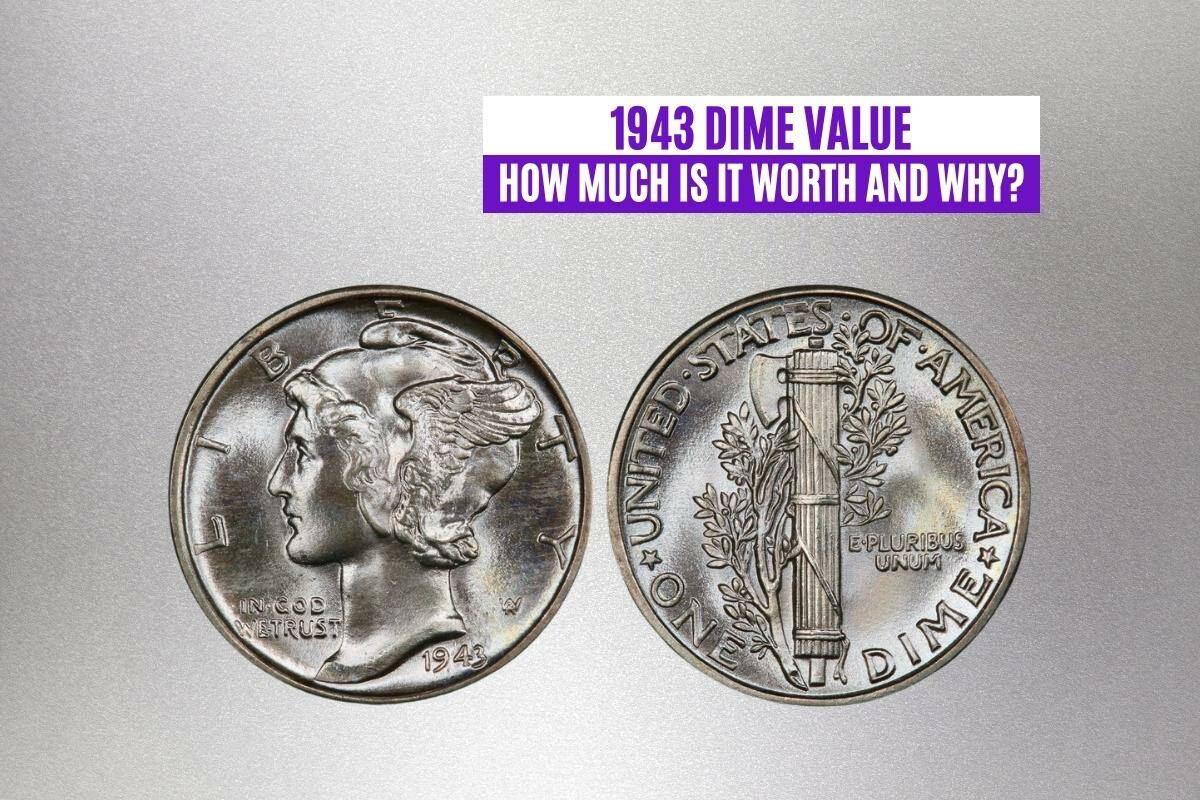Despite the international turbulence that 1943 brought, being the mid-point of World War II, the U.S. Mint continued producing high-quality coinage. One of the coins produced this year was the Mercury dime, a ten-cent coin with a Roman-inspired design.
While this coin was worth $0.10 at its release, it’s worth far more today. The 1943 dime value varies significantly depending on coin condition and rarity, but all are worth many times their original worth.
This guide will delve into the estimated value of this coin, helping you ensure that you buy and sell 1943 Mercury dimes for market-appropriate prices.
1943 Mercury Dime Value Chart
| Variety | MS-66 | MS-67 | MS-68 |
| 1943-P Dime | $40 | $75 | $425 |
| 1943-P Dime FB | $60 | $300 | $10,000 |
| 1943-D Dime | $45 | $75 | $550 |
| 1943-D Dime FB | $60 | $135 | $1,450 |
| 1943-S Dime | $40 | $85 | $500 |
| 1943-S Dime FB | $90 | $400 | $3,650 |
1943 Mercury Dime: History
The ten-cent dime isn’t the oldest denomination in U.S. coinage, with the one-cent penny predating it by about three years. However, the dime has existed for over two centuries, making it a well-established part of U.S. currency.
Initially introduced in 1796 (the same year as the quarter dollar coin), the dime has enjoyed multiple changes since its inception. The Mercury dime is one of the most iconic forms the dime has ever taken.
The Mercury dime, also called the Winged Liberty Head dime, was introduced in 1916 and replaced with the Roosevelt dime in 1946. In 1943, the U.S. Mint set a new record for dime production, striking more than 324 million Mercury dimes.
Although this record was trumped the following year, the U.S. Mint’s dime production wouldn’t reach new heights (400 million or more per year) until the early 1960s. Consequently, while the 1943 Mercury dime grows rarer with each passing year, it’s one of the most plentiful years for the now-defunct Mercury dime.
1943 Mercury Dime: Design
The Mercury dime design remained consistent during its tenure (1916 to 1945). This design, created by German immigrant Adolph Alexander Weinman, featured a highly stylized obverse (front) image of a youthful Lady Liberty.
In this image, Lady Liberty wore a winged Phrygian cap (also called a pileus). This cap is anything but modern, with roots tracing back to the ancient Greeks and Romans. And because the cap featured small wings, many observed that the Mercury dime’s obverse image looked quite similar to the Roman god Mercury.
Mercury (Hermes in Ancient Greece) was the god of finance and wealth. So, placing a modified image of him on a coin made historical sense. However, the design’s creator, Adolph Weinman, didn’t intend for this comparison.
The coin’s official name, the Winged Liberty Head dime, was quickly overshadowed by its colloquial title, the Mercury dime. This unofficial title has become the more long-lasting and publically accepted for the coin, even though the coin’s designer never intended to depict the Roman god Mercury.
Still, it’s impossible to deny that the coin’s decorative elements and font are highly indicative of the Roman Empire and its coinage. So, for better or worse, the Mercury dime is considered one of the “most Roman” U.S. coins ever created.
1943 Mercury Dime Obverse
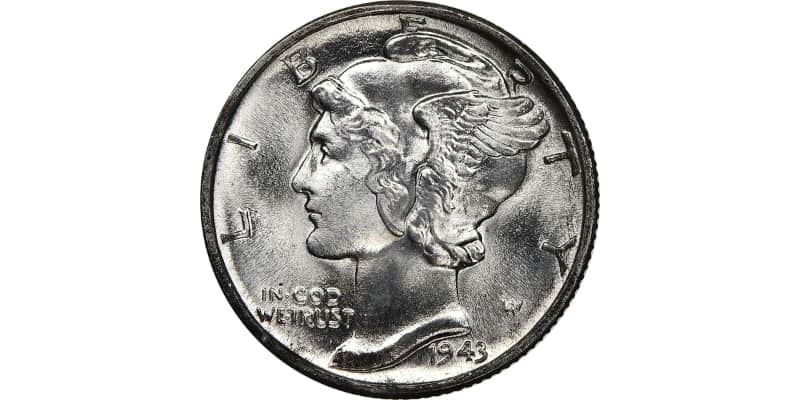
On the obverse (front) side of the 1943 Mercury dime, you’ll see:
- In the coin’s center, a device (raised image) of Lady Liberty wearing a winged Phrygian cap, face in profile looking left
- In the lower left-hand corner, the motto “IN GOD WE TRUST”
- Along the top half of the coin, arching to conform with the coin’s edge, the legend “LIBERTY’
- Beneath Lady Liberty’s neck, toward the lower right bottom of the coin, the year date (1943)
- Along the bottom right, the designer’s initials “AW” (laid over each other with the W sitting slightly above the A)
1943 Mercury Dime Reverse
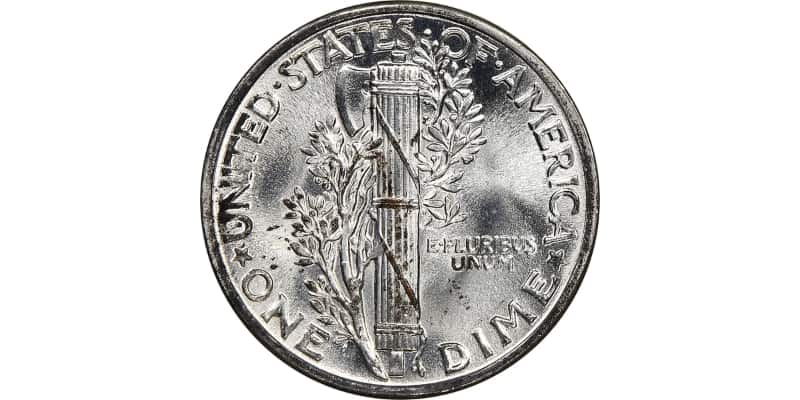
On the reverse (back) side of the 1943 Mercury dime, you’ll see:
- At the top, the issuing nation “UNITED STATES OF AMERICA” (each word separated by interpoints and flanked by five-point stars)
- In the lower-center right, the motto “E PLURIBUS UNUM”
- At the bottom, the coin denomination “ONE DIME”
- A mint mark (D or S) between the “ONE” and “DIME” (not found on 1943-P No Mint Mark dimes)
- A device (raised image) of a fasces (a bundle of tied sticks with an axe sticking out of it) and a vertical olive branch
1943 Mercury Dime: Features and Specifications
The design for all 1943 Mercury dimes remains consistent, with the only changes being the letter used for the mint mark (or the absence of a mint mark). In addition to design, these silvery coins have several shared features, including metal composition and weight.
For example, 1943 Mercury dimes:
- Are 10% copper and 90% silver
- Weigh 2.5 grams (about 0.09 ounces)
- Have a diameter of 17.9 millimeters (about 0.7 inches)
- Feature ridges along their edges (called a reeded edge)
How Much Is a 1943 Mercury Dime Worth?
According to the NGC Price Guide, a 1943 No Mint Mark Mercury dime in circulated condition is worth between $3 and $4. This coin can be worth $6.5 to $425 or more in uncirculated condition.
1943 Mercury Dime: Value Comparison
The U.S. Mint struck over 324 million Mercury dimes across three facilities in 1943; the Philadelphia Mint, the Denver Mint, and the San Francisco Mint. Notably, this was the first year since 1935 that the U.S. Mint didn’t produce any proof-strike pieces. As such, all 324 million Mercury dimes produced in 1943 entered circulation.
This lack of proof-strike coins has had an immense effect on current 1943 Mercury dime values. After all, heavy circulation leaves coins looking worse for wear, with smoothed designs, scratches, and discolored portions.
Consequently, many of the most valuable 1943 Mercury dimes are those in uncirculated condition. These dimes are also exceptionally rare thanks to the high circulation nature of these coins.
Design is another aspect to consider when evaluating the worth of 1943 Mercury dimes.
Mercury dimes showing “Full Band” marks around the fasces (bound sticks) on the coin’s reverse side are tremendously more valuable than their partial-band counterparts. The “Full Band” designation also relates to coin condition, as only Mercury dimes kept in about uncirculated or uncirculated condition show these design elements.
To determine the value of any given 1943 Mercury dime, we need to consider the following:
- Rarity (via mint mark)
- Coin condition (represented by an NGC or PCGS grade)
- The Full Band (FB) design element
For easier evaluation, let’s divide these coins by mint mark!
1943 No Mint Mark Mercury Dime Value
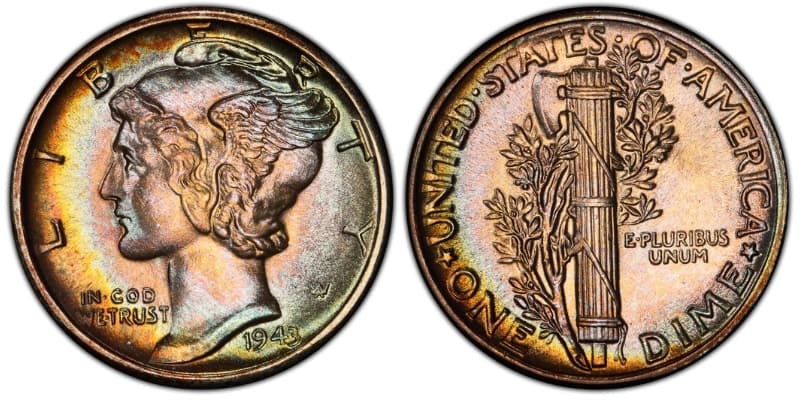
The 1943 No Mint Mark Mercury dime (also called the 1943-P dime) is so-called because it doesn’t have an identifying mint mark on its reverse side. These dimes were struck at the Philadelphia Mint, which produced more Mercury dimes in 1943 than any other U.S. Mint facility (more than 191 million).
Because the No Mint Mark 1943 Mercury dime is the most common of the three mint mark types, it’s generally the least valuable. A 1943-P No Mint Mark Mercury dime in good condition (G-4) has an estimated value of about $3, while one in about uncirculated condition (AU-50) is worth about $3.60.
Still, in uncirculated condition (mint-state), these dimes can be far more valuable. For example, an MS-68 1943 No Mint Mark dime is worth about $425. That said, Full Band No Mint Mark dimes are worth far more.
Full Band
While about 65,000 1943-P Mercury dimes exist today, only about 10,000 Full Band 1943-P dimes have survived to the present day. As such, these dimes are far rarer, making them inherently more valuable. Their more striking and well-defined reverse design also appeals to collectors, raising demand.
All FB 1943 No Mint Mark Mercury dimes are in uncirculated condition (grade MS-60 or higher). An MS-60 FB 1943-P dime is worth about $8.50, while an MS-68 FB 1943 No Mint Mark dime has an estimated worth of $10,000.
No other dime (regardless of whether it’s FB or non-FB) is worth as much as an MS-68 Full Band 1943 No Mint Mark dime. This might seem strange, especially considering the fact that this coin isn’t as rare as other FB 1943 dimes (particularly those struck at the San Francisco Mint).
But it’s important to remember that the likelihood of finding such a common coin in stellar, uncirculated condition is low, making it a rare and valuable find.
1943-D Mercury Dime Value
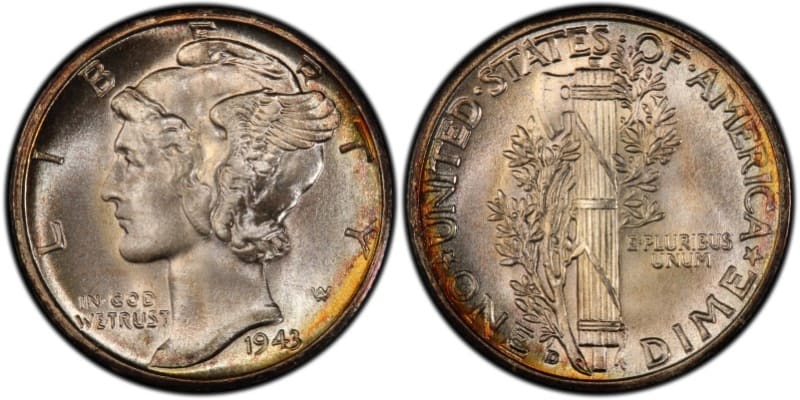
The Denver Mint struck just under 72 million Mercury dimes in 1943, more than the San Francisco Mint but markedly less than the Philadelphia Mint. Like the other 1943 dimes, 1943-D Mercury dimes are available in both Full Band and “regular” varieties.
A non-FB 1943-D Mercury dime is worth about $3 in good condition (G-4) and $3.75 in about uncirculated condition, putting it on par (in terms of value) with the non-FB 1943-S dime.
In uncirculated condition, the 1943-D Mercury has an estimated value ranging between $6.50 (MS-60) and $550 (MS-68). Overall, this coin is worth more than non-FB 1943 No Mint Mark dimes, likely due to its increased rarity (only 40,000 of these Mercury dimes are believed to have survived to the current day).
Full Band
According to PCGS, about 20,000 Full Band 1943-D Mercury dimes have survived the passing decades. This makes the 1943-D FB dime slightly more common than its No Mint Mark counterpart. As you might imagine, this increased commonness decreases the coin’s value.
Still, Full Band 1943-D Mercury dimes are generally more valuable than the non-FB ones. In MS-60 condition, this coin is worth about $8.50. In MS-68 condition, it’s worth about $1,450.
But the most valuable 1943-D FB Mercury dimes are those with a coin grade of MS-68+. These Mercury dimes can sell for $9,500 or more, making them almost as valuable as the FB 1943 No Mint Mark dime.
1943-S Mercury Dime Value
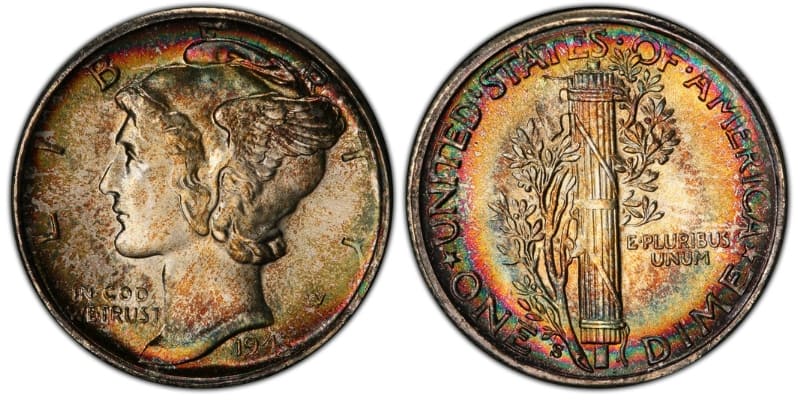
Of all the U.S. Mint facilities that produced Mercury dimes in 1943, the San Francisco Mint produced the fewest, with a total mintage of 60.4 million. Consequently, dimes featuring the “S” mint mark on their reverse sides were the rarest in 1943; they’re also considered the rarest 1943 dimes today.
Like other 1943 dimes, the 1943-S Mercury dime is found in both regular strike and Full Band (FB) varieties, and the FB coins tend to have a higher overall worth due to their rarity and clear design.
Non-FB 1943-S Mercury dimes are worth about $3 in good condition (G-4) and $3.75 in about uncirculated condition (AU-50). In uncirculated condition (MS-60 grades or higher), these dimes are worth between $8 (MS-60) and $500 (MS-68).
Full Band
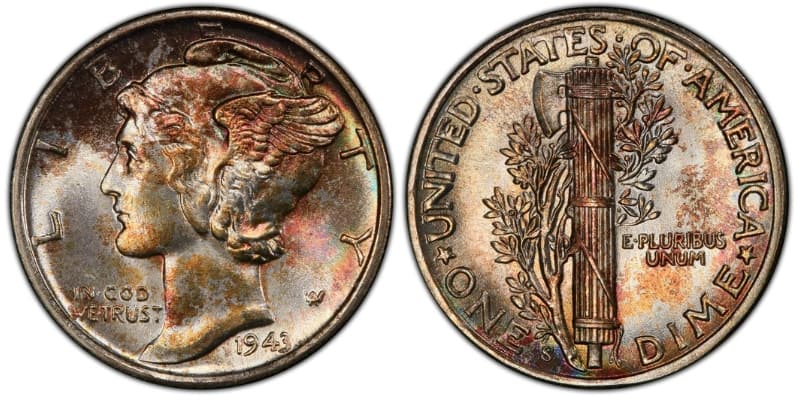
Because the Full Band design element is generally only found on coins that saw little to no circulation, FB 1943-S Mercury dimes are typically only available in uncirculated condition.
A 1943-S Full Band dime with a grade of MS-60 has an estimated value of $9.50, while one with a grade of MS-68 is worth $3,650 or more. Still, Full Band 1943-S dimes are rare, with a comparatively low survival estimate of only 8,000.
1943 Mercury Dime: Rare Errors
By 1943, the U.S. Mint was using hi-tech (at the time) industrial machinery to speed up the coin-striking process. This machinery helped the U.S. Mint reach new production highs, including those they experienced for dimes in 1943 and 1944.
But even the best-maintained machines can eventually wear down or experience mechanical problems. Additionally, human error is a constant in every industry, even one as highly respected and long-lived as coin production.
As a result, a handful of 1943 Mercury dime error coins made their way into circulation and private collections. Because non-error 1943 dimes are exceedingly rare, those displaying errors are considered incredibly scarce. Most of these coins (particularly those in uncirculated condition) can sell for incredible prices at auction.
To illustrate this fact, let’s briefly discuss two types of 1943 Mercury dime errors:
- The curved clip error, and
- The off-center error
1943 Mercury Dime Curved Clip Error
The small metal blanks (planchets) that become coins aren’t always error-free. Sometimes, these discs feature punching errors that cause them to end up imperfectly round, with a clipped edge rounded toward the coin’s center.
Imagine cutting out a portion of a coin using a toenail clipper. That’s essentially what this error resembles!
When these planchets are fed between coin dies, they create a curved clip error coin. This type of coin is missing part of its design due to the clipped edge, and those with year dates still intact often outsell those with missing dates.
A 1943 Mercury dime with a curved clip error can sell for hundreds of dollars. In 2021, MS-63 Full Band 1943-P Mercury dime sold at auction for $264.
1943 Mercury Dime Off-Center Error
When coin planchets aren’t perfectly centered between coin dies during the striking process, the designs impressed by the dies are off-center, leaving part of the original metal disc blank. This type of minting error is called the off-center error.
Off-center errors are measured in percentages, with low percentages showing only minor off-center strikes and high percentages showing much more of the original blank planchet. Generally, high-percentage off-center error coins are more valuable than low-percentage ones.
Still, as with non-error coins, coin grade also impacts the value of an off-center 1943 Mercury dime.
For example, a scratched 5% off-center 1943 dime sold for $37 in 2004. But in 2021, an MS-63 40% off-center 1943 Mercury dime sold at auction for $1,680! The latter coin’s higher grade and off-center percentage are the primary reasons it sold for a much higher price.
Frequently Asked Questions
Do you have additional questions about the 1943 Mercury dime? If so, please peruse the frequently asked questions below!
How Many 1943 Mercury Dimes Exist?
Current estimates put the surviving total of 1943 Mercury dimes at about 193,000 (across all coin grades). For perspective, that’s only about 0.06% of the total number of dimes struck in 1943!
What’s the Rarest 1943 Mercury Dime?
The rarest type of 1943 Mercury dime is the 1943-S Full Band Mercury dime. It’s thought that only about 8,000 of these dimes exist today (across all coin grades).
What’s the Most Expensive 1943 Mercury Dime Ever Sold?
The most expensive non-error 1943 Mercury dime ever sold at auction was an MS-68 1943-P No Mint Mark Full Band dime. This coin sold for $19,550 in 2010.
Are There Any Proof-Strike 1943 Mercury Dimes?
There aren’t any proof 1943 Mercury dimes. Proof-strike Mercury dimes were only released between 1936 and 1942.
That being said, there are “prooflike” 1943-S Mercury dimes. These dimes were likely removed from circulation early after release, allowing them to retain their original qualities and condition, including the Full Band design on the reverse side.
Final Thoughts
Although the Mercury dime was a slightly controversial coin during its heyday, it’s become one of the most coveted and beloved U.S. dimes thanks to its distinct look and high silver content.
The 1943 Mercury dime, produced at the height of World War II, was once incredibly common, with more than 324 million pieces in circulation. But because this dime is rarer nowadays, the 1943 dime value far exceeds its original value of $0.10. Some (like the MS-68 1943 No Mint Mark dime) are worth thousands of dollars!
For more coin value guides, check out these related articles!

